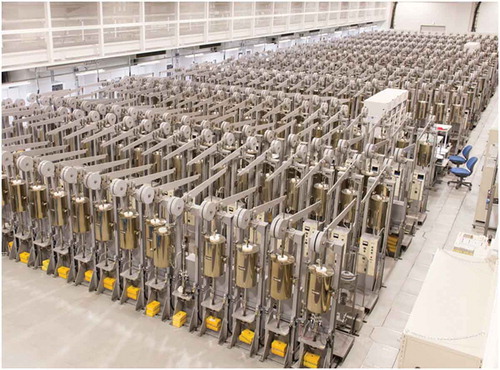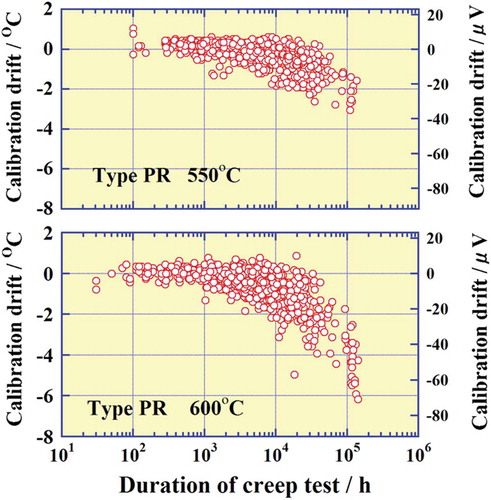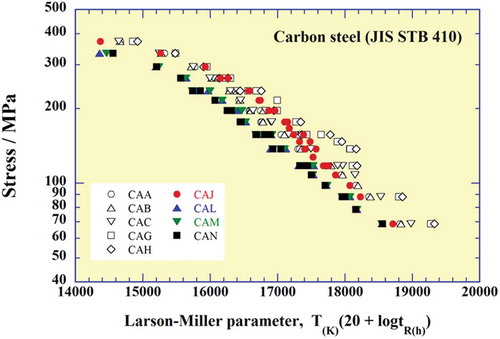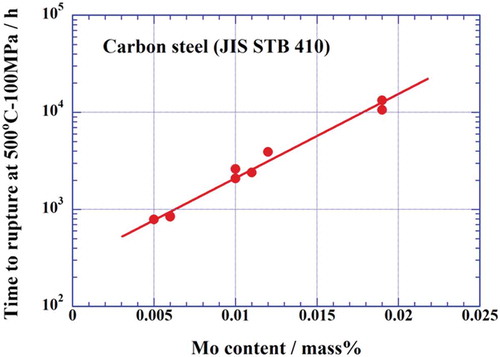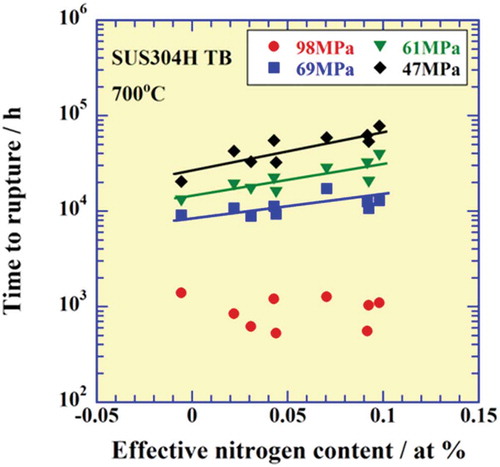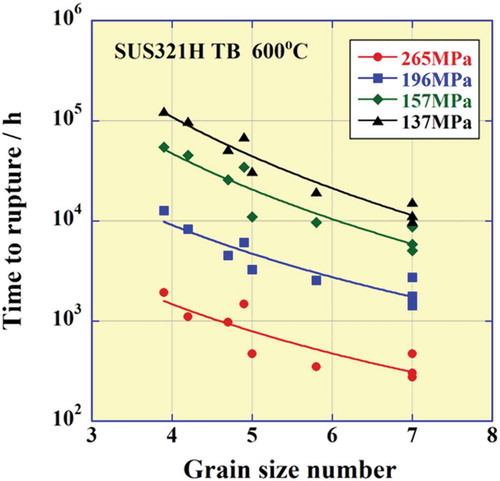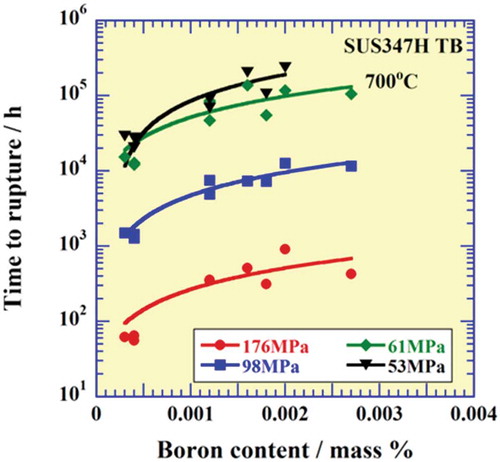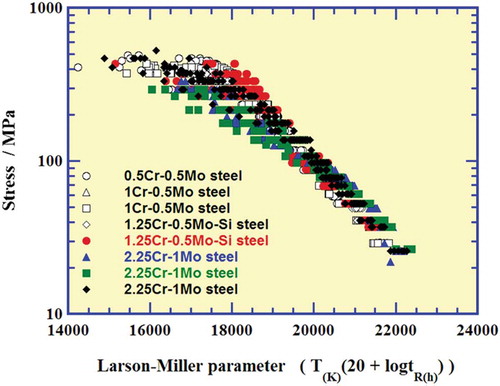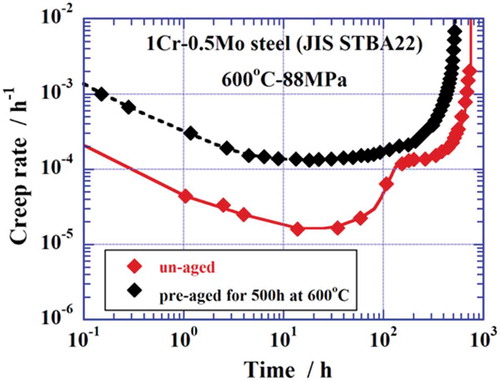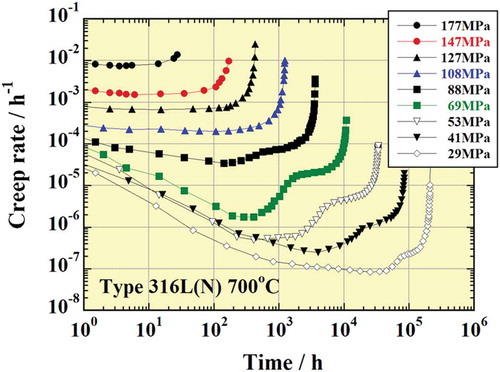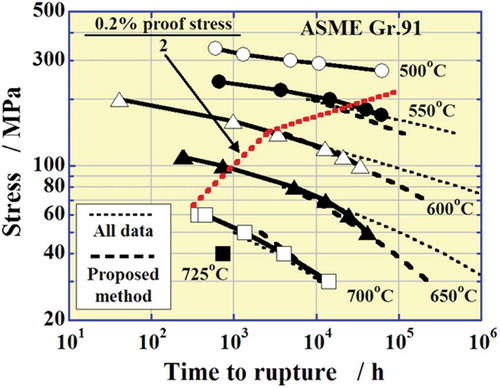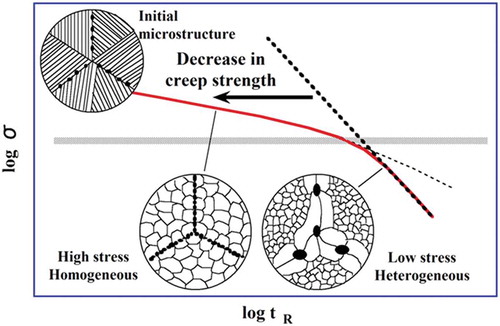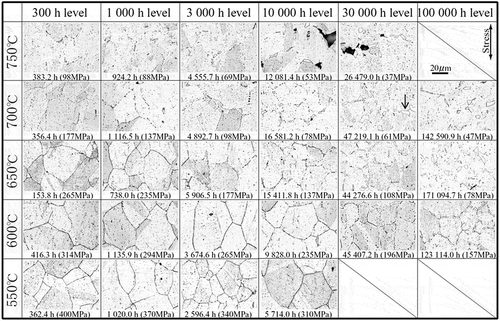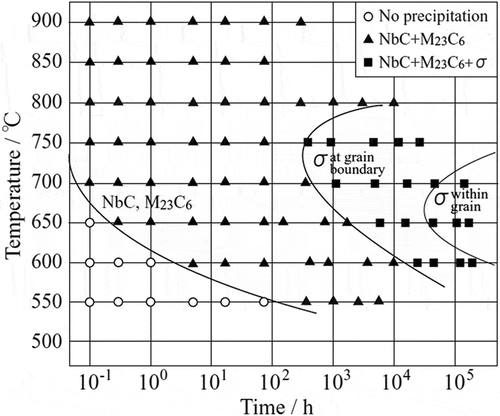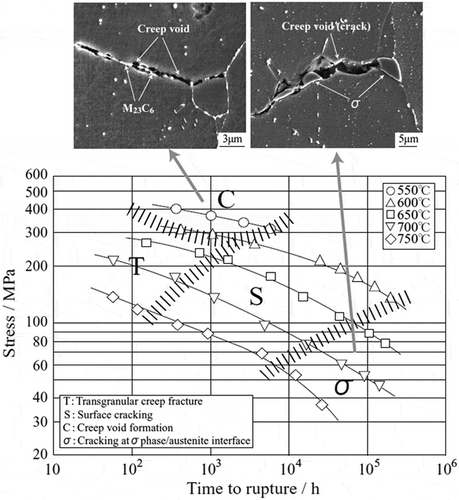ABSTRACT
The background of the NIMS Creep Data Sheet Project, together with the preliminary study and facilities, material selection, and testing method, is summarized. The outcomes from the project are explained, focusing on the long-term creep strength of ferritic and austenitic heat-resistant steels. In some cases, the slope of the stress versus time-to-rupture curve in the long term differed from that in the short term in a manner that was markedly dependent on the type of material. Heat-to-heat variations in creep strength were recognized for ferritic and austenitic steels, even when the chemical compositions of the steels examined were within the range of specifications. The reasons for the heat-to-heat variations were differences in the chemical composition, in the amounts of minor elements, and in the grain size, among others. The existence of inherent creep strength was discovered in the very long term for ferritic heat-resistant steels. The amounts of minor solute elements affect the inherent creep strength, independently of precipitation strengthening or the dislocation structure. An inflection point was observed in the tertiary creep stage for a low-alloy steel and for austenitic stainless steels when precipitation occurred during creep. A region-splitting analysis method was proposed for long-term creep strength evaluation for high-chromium ferritic steels. This method was used to review the allowable stress of high-chromium ferritic steels in Japan. A metallographic atlas, time–temperature–precipitation diagram, and fracture-mode map were proposed for ferritic and austenitic steels on the basis of creep-ruptured specimens.
Graphical Abstract

CLASSIFICATION:
1. Introduction
1.1. Background of the NIMS creep data sheet project
In power plants, materials for boiler and turbine components are used for a long time under a stress at the elevated temperature. Creep deformation can occur under a stress at the elevated temperature for materials of power plant components. The time to rupture for creep deformation is usually dependent on the stress and on the temperature. In actual power plants, the design life of components, based on creep fracture, is expected to be about 100 years or more, because stress due to high-temperature steam should be less or equal to the allowable stress. For the safety of power plants, the allowable stresses for materials of components need to be determined based on long-term creep properties. The creep rupture strength for 100,000 h (about 11.4 years) is normally required for determining the allowable stress for the ASME Boiler and Pressure Vessel Code [Citation1].
In Japan, many power plants and petrochemical plants were constructed on the basis of foreign technologies introduced in the 1960s. As a result, the allowable stresses for the construction of these plants were based on the Japanese ministerial ordinance referring to the allowable stresses of ASME Boiler and Pressure Vessel Code. It was difficult to determine the allowable stresses based on the creep date of materials manufactured in Japan because insufficient creep data were available for materials manufactured in Japan [Citation2]. In consequence, long-term creep test data for materials manufactured in Japan were urgently required to confirm that the expected long-term creep strengths were in accord with the allowable stresses regulated by the technical standards referring to ASME Boiler and Pressure Vessel Code. At first, in the Creep Committee of the Iron and Steel Institute of Japan (ISIJ), personnel from academia and from industry discussed a scheme to produce creep data sheets, focusing on material selection and testing methods. The National Research Institute for Metals (NRIM; currently NIMS) took over the scheme and began a creep data sheet project in 1966. The goal of the project was to determine the 100,000-h creep rupture strength of heat-resistant steels and alloys manufactured in Japan. The need for creep data sheets has evolved in response to societal and economic changes in Japan. Creep data were initially required for determining allowable stresses for the construction of plants, but more recently, creep data have been used in assessing the residual life assessment of components in aging plants.
1.2. Preliminary study and facilities
Before the creep data sheet project began, preliminary studies were conducted to standardize creep machines and procedures for creep testing, focusing on single-lever and multi-lever creep machines. The main topics were as follows:
the load accuracy of creep machine,
the distribution of temperature- and time-dependent fluctuations of temperature during creep testing,
scattering of the creep rupture life,
size effects of specimens on creep strength,
measurement accuracy of creep strain, and
statistical analysis of creep data.
The installation of the specimen, differences in specimen diameter, differences in temperature, the sampling location of the specimen, and the size of the specimen were shown to have little effect on the result of creep rupture life up to 30,000 h.
In the 1960s, a creep-testing laboratory was established in Meguro, Tokyo, with a power incoming unit, an emergency power generator, and an air conditioner. In fact, the emergency power generator has supplied electricity to the creep-testing machine during creep testing four times when power failures occurred, in addition to regular service during legal inspections of the electrical equipment. Several types of creep-testing machine were installed in the creep-testing laboratory: there were 878 single-lever creep-testing machines, 144 multi-lever creep-testing machines, and 46 others.
The creep-testing machines were moved from Tokyo to Tsukuba in 2011, as a result of the closure of the creep-testing laboratory in Tokyo at the end of March 2012. shows a photograph of the creep-testing laboratory in Tsukuba, where there are now a total of 500 single-lever creep-testing machines.
1.3. Material selection
The Creep Committee of ISIJ selected materials for creep testing based on the needs of various industries until 1986. After 1986, an advisory board and a technical advisory committee were established in the NRIM as a result of the disbandment of the Creep Committee of ISIJ. The advisory board and the technical advisory committee were made up of members from academia and industry in Japan. The committee members selected materials for creep testing based on the needs of the industry. The criteria for material selection were as follows:
materials manufactured in Japan,
commercial materials,
two or more companies can manufacture the material,
actual production,
materials specified in codes or standards,
materials for boilers, turbines, heat exchangers, pressure vessels, and reactors in plants, and
materials that will be used in the near future and that are important.
1.4. Creep data collection in foreign countries
In Europe, the European Creep Collaborative Committee (ECCC) was established in 1992 [Citation3]. Its main purpose is to determine creep strength properties for allowable stress in European codes and standards. European institutions are jointly collecting creep data and discussing methods for evaluating creep data.
2. List of creep data sheets and creep data summaries
Creep data sheets are listed in [Citation4–Citation63]. The creep data sheets are numbered from 0 to 59, with optional letters. For example, ‘A’ in No. 43A means the first revised edition, in that the longest time to rupture in the creep data sheet is extended from 30,000 to 50,000 h. Similarly, ‘B’ in No. 1B means the second revised edition, in which creep rupture data for more than 100,000 h are included in the creep data sheet. Without ‘A’ or ‘B’, the data sheet is the first edition and includes creep rupture data for more than 10,000 h. The materials are mainly ferritic and austenitic heat-resistant steels or superalloys. The product forms are tubes, pipes, plates, bars, or forged items depending on the material. The material specifications are those of the Japanese Industrial Standards (JIS), the American Society for Testing and Materials (ASTM), the American Society of Mechanical Engineers (ASME), or the material specifications in the Technical Regulations for Equipment for Thermal Power Plants, as established by the Ministry of Economy, Trade and Industry (METI) of the Japanese Government. For the creep data sheet, two or more heats are selected for each material. The main contents of the creep data sheets are as follows:.
Details of the material:
Type of melting, size of ingot, deoxidation process, product form, dimensions, processing and thermal history, austenite grain-size number, Rockwell hardness, nonmetallic inclusions.
Chemical composition
Short-term tensile properties (room temperature and elevated temperatures):
0.2% Proof stress, tensile strength, elongation, reduction of area.
Creep rupture data:
Time to rupture, rupture elongation, reduction of area.
Relationship between minimum creep rate and stress
Relationship between minimum creep rate and time to rupture (Monkman–Grant)
Optical micrographs:
As-received sample, creep-ruptured sample.
Profiles of creep-ruptured specimens
Creep data for all the materials examined as of 1 August 2019 are summarized in . In some cases, creep tests were interrupted when the time to rupture was estimated to be too long. shows details of creep rupture data in case of time to rupture after more than 300,000 h.
Table 1. List of NIMS creep data sheets.
Table 2. Summary of creep data of all materials examined as of 1 August 2019.
Table 3. Long-time creep rupture data (more than 35 years).
3. Testing method
3.1. Creep testing
Creep tests were performed based on JIS Z 2271:2010, Metallic materials: Uniaxial creep testing in tension: Method of test. Temperature control was based on JIS Z 2271:1999. The tests were conducted under a constant load in air on specimens of 6 mm in gauge diameter and 30 mm in gauge length or 10 mm in gauge diameter and 50 mm in gauge length. To start the creep test, the stress was loaded in a stepwise manner to obtain the relationship between stress and strain. The zero point of strain normally showed a deviation due to the clearance of the junction of the creep-testing machine. The zero point of the strain was estimated from the relationship between the stress and the strain. A fitting curve is fixed for elastic region in the relationship. The zero point of strain is determined when the fitting curve is extrapolated to zero value of stress. Instantaneous strain can be accurately evaluated by using the zero point of strain. The displacement of the creep specimen was continuously measured by a dial gauge or by a linear gauge with an extensometer for high-temperature use attached to the gauge portion of the creep specimens during testing.
3.2. Temperature control
The testing temperature was continuously measured by thermocouples attached to the gauge portion of the creep specimens during testing. The temperature was controlled by reference to the measured temperature of specimens during testing. Type PR thermocouples were used up to 1980. After that, Type R thermocouples were used, because of a revision of JIS C 1602:1981. The thermocouples were accurately calibrated by using standard thermocouples. The standard thermocouples were traceable to International Temperature Scale-90 (ITS-90). After creep testing, the thermocouples were repaired by electrical annealing, because their thermoelectromotive force usually changed after long-term creep testing, as shown in [Citation64]. The thermoelectromotive force can be restored by electrical annealing. Fluctuations in the test temperature were maintained within ±1.5°C during long-term creep testing.
4. Outcomes
Several outcomes were obtained from the NIMS Creep Data Sheet, as discussed below.
4.1. Characteristics of long-term creep properties
shows the creep rupture strength of JIS STBA12 (0.5Mo steel) [Citation12], ASTM A542 (2.25Cr–1Mo steel) [Citation40] and JIS STBA 25 (5Cr–0.5Mo steel) [Citation16]. The trend in creep strength in the long term is almost the same as that in the short term for JIS STBA25. On the other hand, the long-term creep strengths extrapolated from creep data in the short term are apparently higher than experimental values in the long term for JIS STBA12 and ASTM A542. This indicates that the long-term creep strength property is markedly dependent on the type of material. The initial microstructure and the process of microstructural change during creep exposure can affect creep strength properties. Degradation and the damage mechanism during creep exposure depend on the stress and temperature conditions. Therefore, to understand the long-term creep strength properties, microstructural changes and damage processes during creep exposure need to be investigated.
The creep rupture ductilities for JIS STBA24, SCMV4NT, and ASTM A542 steels are shown in [Citation65]. The nominal composition of these three steels is 2.25Cr–1Mo and their initial microstructures are ferrite–pearlite, bainite, and tempered martensite, respectively. The horizontal axis of is the Larson–Miller parameter (LMP) with a parameter constant of 20. For JIS STBA24 and SCMV4NT, the reduction of the area increases monotonously with increasing LMP, meaning that the creep rupture ductility is higher in the long term. However, for ASTM A542, the reduction of area decreases with increasing LMP, reaches a minimum, and then increases in the long term. It has been reported for ASTM A542 [Citation65] that the martensite lath preferentially recovers near prior austenite grain boundaries during creep. Creep deformation can be concentrated near prior austenite grain boundaries, leading to low creep rupture ductility [Citation65]. In the very long term, the martensite lath recovers, even in the prior austenite grain interior [Citation65]. This means that uniform creep deformation can occur in the very long term, leading to high ductility.
4.2. Heat-to-heat variations of creep strength
shows the relationship between stress and the LMP for the carbon steel JIS STB410 [Citation11]. The chemical compositions of all heats are in the range of specification [Citation11]. The creep rupture strength strongly depends on the heat. The heat-to-heat variation of time to rupture is about one order of magnitude at all stress levels examined. The fitting curves for all heats by the LMP are shown in [Citation66]. There are no large differences in the slopes of the fitting curves. The curves can be divided into three groups, depending on the amount of Mo. The time to rupture is longer in the high-Mo carbon steels than in the low-Mo ones. shows the relationship between the estimated time to rupture and the Mo content [Citation66]. The time to rupture at 500°C and less than 100 MPa was estimated by using the fitting curve shown in . The time to rupture apparently increases with increasing Mo content. Onodera et al. calculated the equilibrium solute elements and atomic pairs for carbon steels by using Thermo-calc [Citation67]. A good correlation between the concentration of Mo–C and Mn–C atomic pairs and the creep rupture strength was shown by this calculation. The grain size normally affects the creep rupture strength [Citation68]; however, the effect of grain size on the creep rupture strength was not confirmed for carbon steels [Citation66].
shows creep rupture strengths of plain 12Cr steels [Citation17] and 12Cr–1Mo–1W–0.3V steels [Citation14] at 550°C. For both steels, the chemical compositions of all heats are in the range of specification [Citation14]. However, the heat-to-heat variation of the time to rupture is about one order of magnitude for both steels. Abe investigated the reason for this heat-to-heat variation in terms of the initial strength and the chemical composition [Citation69]. In the case of the plain 12Cr steel, the short-term creep strength increased with increasing initial strength (for example, the 0.2% proof stress and ultimate tensile strength) at the creep-testing temperature [Citation69]. However, the initial strength had no effect on the creep strength for the 12Cr–1Mo–1W–0.3V steel [Citation69]. Abe proposed that the effective nitrogen content might explain the heat-to-heat variation in the time to rupture [Citation69]. The effective nitrogen content is defined as the solute nitrogen content, because much nitrogen is consumed in forming AlN and TiN. The solute nitrogen can form vanadium nitride, which is a strengthening factor for plain 12Cr steel and for 12Cr–1Mo–1W–0.3V steel. For 12Cr–1Mo–1W–0.3V steel, the relationship between time to rupture and the effective nitrogen content is shown in [Citation14,Citation54,Citation69]. The time to rupture increased with increasing effective nitrogen content.
Figure 9. Relationship between time to rupture and effective nitrogen content for 12Cr-1Mo-1W-0.3V steels.

Abe also investigated the reason for heat-to-heat variations for several types of austenitic stainless steel [Citation70]. shows the creep rupture strengths of SUS304HTB, SUS321HTB, and SUS347HTB [Citation8,Citation9,Citation32]. For SUS304HTB, the heat-to-heat variation of the time to rupture is large in the long term, but not so large in the short term. On the other hand, heat-to-heat variations of time to rupture are very large in the short and the long term for both SUS321HTB and SUS347HTB. The heat-to-heat variation of time to rupture in the short term for SUS304HTB is due to the difference in the content of Nb, which can form NbC [Citation70]. shows the chemical compositions of the SUS304HTB [Citation8]. The effective nitrogen content is also important for austenitic stainless steels, because effective nitrogen can contribute to solid-solution strengthening. shows the relationship between the time to rupture and the effective nitrogen content for SUS304HTB [Citation8,Citation70]. At low stresses, the time to rupture increased with increasing effective nitrogen content. In the case of SUS321HTB, the difference in grain-size number is the main reason for the heat-to-heat variation of the time to rupture, as shown in [Citation9,Citation70]. The difference in grain size is due to the Ti content of SUS321HTB [Citation70], which is much higher than that of SUS304HTB. Therefore, most nitrogen is consumed as TiN in SUS321HTB, so that the amount of effective nitrogen is negligible [Citation70]. shows the relationship between the time to rupture and the boron content of SUS347HTB [Citation32,Citation70]. The time to rupture increased with increasing boron content under low- and high-stress conditions, showing that the main reason for the heat-to-heat variation of the time to rupture is the difference in boron content.
Table 4. Chemical compositions (mass%) of SUS304HTB steel.
Figure 10. Relationship between stress and time to rupture for SUS304HTB, SUS321HTB and SUS347HTB steels.
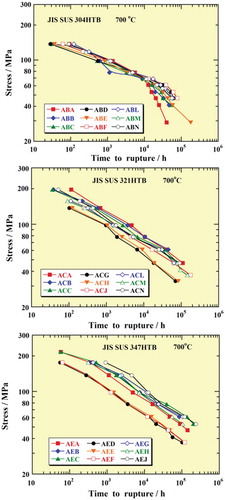
Therefore, there are heat-to-heat variations in creep strength for commercial heat-resistant steels, and the reasons for these variations depend on the type of steel.
4.3. Inherent creep strength
shows the relationship between the LMP and stress for several ferritic heat-resistant steels [Citation5–Citation7,Citation15,Citation24,Citation25,Citation39,Citation40]. The LMP constant used for evaluation was 20. In the short term, the creep strength strongly depends on the type of steel. For example, the difference in creep strength at 300 MPa is more than three orders of magnitude in the time to rupture. On the other hand, the difference in creep strength becomes very small in the long term as compared with that in the short term. The creep strength in the long term is referred to as the ‘inherent creep strength’ [Citation71,Citation72]. A schematic drawing explaining the inherent creep strength is shown in [Citation72]. In the short term, the creep strength depends on the kind of steel, because the microstructural morphology and strengthening factors such as solid-solution or precipitation strengthening also depend on the composition of the steel. However, the creep strength decreases in the long term because microstructural changes, such as the recovery of the dislocation structure and coarsening of precipitates, occur during creep. In the very long term, the effects of strengthening, which depend on the microstructural morphology, such as precipitation strengthening, disappear and the creep strength are almost the same for all ferritic heat-resistant steels, indicating that this is the inherent creep strength. According to , retardation of microstructural changes can contribute to an improvement in the long-term creep strength. Furthermore, an increase in solid-solution strengthening can improve the inherent creep strength itself. The creep strength of ASME Gr.91 (9Cr–1Mo–V–Nb–N) steel is superior to that of conventional ferritic steel [Citation73]. The carbonitrides MX (M = V, Nb; X = C, N) produce an extreme increase in the creep strength of ASME Gr.91 steel, because the coarsening rate of the MX carbonitrides is very small during creep exposure [Citation74]. It has been reported that the addition of boron increases the creep strength of 9Cr steel [Citation75]. The boron is included in M23C6 carbides on prior austenite grain boundaries, leading to a decrease in the coarsening rate of M23C6 carbides during creep exposure, as compared with boron-free 9Cr steel [Citation76].
4.4. Characteristics of creep curves and microstructural changes
Creep curves can provide us with information on microstructural changes during creep exposure. The creep rate versus time curves at 600°C and 88 MPa for JIS STBA22 (1Cr–0.5Mo) steel are shown in [Citation77]. For unaged material, the creep rate increases markedly after a minimum creep rate and then the increase in the creep rate becomes small. On the other hand, at 137 MPa, the presence of typical primary (monotonous decrease in creep rate), secondary, and tertiary creep (monotonous increase in creep rate) stages was confirmed. An inflection during tertiary creep is also observed at stresses lower than 88 MPa. A large number of fine carbides several tens of nanometers in size were observed in the as-received specimen of JIS STBA22 steel [Citation77]. Dislocations were pinned by the fine carbides during creep, up to the inflection point at around 150 h shown in [Citation77]. However, the carbides abruptly coarsened after the inflection point at around 150 h, indicating a decrease in precipitation strengthening [Citation77]. When pre-aging treatment was performed on the JIS STBA22 steel, the inflection in the creep rate versus time curve disappeared (see ) [Citation77]. The fine carbides observed in the as-received specimen coarsened during pre-aging, indicating that initial precipitation strengthening was reduced during pre-aging.
shows the creep rate versus time curves at 700°C for Type 316L(N) stainless steel [Citation78]. At 88 MPa and below, a remarkable decrease in creep rate was observed in the transient-creep stage, and a hump in the curve appeared in the tertiary creep stage. The creep rate in the transient creep stage is considered to be reduced by precipitation strengthening of the Laves phase. The creep rate increases after showing a minimum value due to the coarsening of the Laves phase; however, the increase in creep rate falls and shows a hump in response to the disappearance of the precipitation-strengthening effect [Citation78]. A hump in the tertiary creep stage has also been reported for KA-SUS304J1HTB (18Cr–9Ni–3Cu–Nb–N) stainless steel [Citation79]. In the case of austenitic stainless steels, which are usually subjected to solution treatment, no precipitates are basically observed before creep, and precipitates such as an M23C6, a σ phase, a Laves phase, and a χ phase are formed during creep exposure. These microstructural changes can result in a complex shape for the creep rate versus time curve, as shown in .
Consequently, to understand the creep strength of heat-resistant steels, microstructural changes and their effects on creep deformation behavior need to be investigated.
4.5. Method for evaluating the long-term creep strength
shows the creep rupture strength of ASME Gr.91 (9Cr–1Mo–V) steel [Citation47,Citation80,Citation81]. The fine dotted line is the curve predicted from the LMP by using all the experimental creep rupture data. In the long term, the fine dotted lines apparently overestimate the creep rupture strength as compared with experimental data. In this case, it is difficult to estimate accurately the 100,000-h creep rupture strength that is used for determining the allowable stress. To predict the accurate 100,000-h creep rupture strength, a region-splitting analysis method was proposed for creep-strength-enhanced ferritic steels [Citation80,Citation81]. The experimental creep rupture data are divided into two regions by the half value of the 0.2% proof stress at the creep-testing temperature, as shown in . The bold dashed line is the curve predicted from the LMP with a parameter constant of 20 by using the experimental data obtained at stresses below the half value of the 0.2% proof stress. The bold dashed line permits an accurate evaluation of the experimental data in the long term. Therefore, region-splitting analysis permits more-accurate prediction of the 100,000-h creep rupture strength. is a schematic representation of microstructural changes at various applied stresses for creep-strength-enhanced ferritic steels consisting of tempered martensite and precipitates. In the high-stress region, the recovery of the martensite structure occurs homogenously during creep exposure, whereas the recovery takes place preferentially around the prior austenite grain boundaries in the low-stress region [Citation80,Citation81]. Creep deformation can essentially occur in weak area such as prior austenite grain boundary. However, other areas such as grain interior can easily deform when the applied stress is very high. Therefore, the creep strength in the high-stress region is smaller than that extrapolated from the data in the low stress-region. The boundary stress is the half value of 0.2% proof stress [Citation80,Citation81]. The half value of 0.2% proof stress corresponds to the proportional limit [Citation81]. The region-splitting analysis method has been applied to review the allowable stress for ASME Gr.91, Gr.92, and Gr.122 type steels in Japan [Citation81–Citation83]. The region-splitting analysis method can also predict accurate long-term creep strengths of low-alloy steels if the microstructure is bainite or tempered martensite [Citation84]. For ASME Gr.91 steel, the creep strength in the low-stress region is still higher than the inherent creep strength of ferritic heat-resistant steels shown in . Therefore, the creep strength of ASME Gr.91 steel will approach the inherent creep strength when the stress is extremely low.
The heat-to-heat variation of creep rupture strength is of concern in relation to reviewing the allowable stress for ASME Gr.91 steel. The effects of the chemical composition, such as the Ni content, and of the initial microstructure, such as Cr segregation, on the creep rupture strength are presently under discussion [Citation85,Citation86].
4.6. Metallographic atlas and fracture-mode map
Metallographic atlases and fracture-mode maps have been investigated for creep-ruptured specimens obtained from the NIMS Creep Data Sheet Project. shows a series of optical micrographs for creep-ruptured specimens of SUS347HTB steel. No precipitates were observed before creep. The formation of precipitates became visible when the time to rupture and the temperature were increased. Large particles could be clearly seen after creep rupture for 47219.1 h at 700°C, as shown by the arrows. The micrographs shown in were obtained from the gauge portions of creep-ruptured specimens. To investigate the effect of stress or strain on microstructural changes during creep exposure, the microstructures of the grip portions of creep-ruptured specimens were also examined. The time–temperature–precipitation (TTP) diagram of SUS347HTB steel is shown in . The results shown in were obtained from the grip portions of creep-ruptured specimens; for example, NbC and M23C6 are formed within 0.1 h at 700°C and a σ-phase starts to form on the grain boundary after about 1000 h. shows the fracture-mode map of SUS347HTB steel, together with SEM micrographs. In the high-stress regime at 550°C, creep voids are formed on grain boundaries during creep exposure. In the low-stress regime, creep voids and cracks are initiated at the interface between the σ phase and the matrix. T and S in represent transgranular creep fracture and surface cracking, respectively. Metallographic atlases and fracture-mode maps have also been reported for SUS304HTB [Citation87,Citation88], SUS316HTB [Citation89], SUS321HTB [Citation90,Citation91], SUS347HTB [Citation91,Citation92], 2.25Cr–1Mo [Citation65], and Cr–Mo–V [Citation93] steels.
5. Conclusions
The NIMS Creep Data Sheet Project began in 1966, following discussions on a scheme for producing creep data sheets initiated by the Creep Committee of the ISIJ. Creep tests were performed on 63 types of heat-resistant steels and alloys to obtain 100,000-h creep rupture data. The results can be summarized as follows:
In some cases, trends in the long-term creep strength data differed from those for short-term creep strength data; however, the differences in trends were small in some steels. The type of material therefore needs to be considered when selecting a method for evaluating long-term creep strength.
In many cases, heat-to-heat variations in the creep rupture strength were confirmed to occur, even within the range of specifications. However, the reasons for these heat-to-heat variations depend on the type of material. Possible reasons, such differences in the chemical composition, the grain size, and the amount of effective minor elements, differed for a wide variety of materials.
An inherent creep strength was recognized in the very long term for ferritic heat-resistant steels. The inherent creep strength depends on the amount of minor solute elements and on solid-solution strengthening.
Creep deformation behavior was complex when precipitation occurred during creep exposure. An inflection was observed in the tertiary stages of the creep rate versus time curves for low-alloy steels and for austenitic stainless steels.
To evaluate the long-term creep strength, a region-splitting analysis method was developed for creep-strength-enhanced ferritic steels with tempered martensite structures. The method was applied in a review of the allowable stresses in Japan for several creep-strength-enhanced ferritic steels.
A metallographic atlas, time–temperature–precipitation diagram, and fracture-mode map were obtained from creep-ruptured specimens for several heat-resistant steels.
Acknowledgments
The authors are grateful to all the members that participated in the NRIM/NIMS Creep Data Sheet project for their earnest efforts.
Disclosure statement
No potential conflict of interest was reported by the authors.
Additional information
Notes on contributors

Kota Sawada
Kota Sawada is a director of Structural Materials Testing Platform in National Institute for Materials Science (NIMS). He received his doctor of engineering in materials science from Tohoku university in 1999. He is the leader of NIMS Creep Data Sheet Project. His research focuses on long-term creep properties and microstructural changes during creep for heat resistant steels and alloys. Recently, he is interested in the effect of segregation on long-term creep strength of ASME Gr.91 and Gr.92 steels.
References
- ASME Boiler and Pressure Vessel Code II.D.M-2019.
- Yokoi S. Long-Term Creep Rupture Testing at NRIM. J Soc Mater Sci Japan. 2003; 22:188–193.
- Thornton DV. Activities of the European Creep Collaborative Committee. In: Strang A et al.,editors. Proceedings of 5th International Parsons Conference on Advanced Materials for 21st CenturyTurbines and Power Plant; 2000 July; Cambridge: IOM: London; 2000. p. 123.
- Sawada K, Kimura K, Abe F et al. General Comments on the Program and Procedure for Creepand Rupture Tests on High-Temperature Materials Manufactured in Japan. NRIM Creep Data SheetNo. 0: National Research Institute for Metals; 1972. DOI: 10.11503/nims.1004
- Sawada K, Kimura K, Abe F et al. Data Sheets on the Elevated-Temperature Properties of 1Cr–0.5Mo Steel Tubes for Boilers and Heat Exchangers (STBA 22). NRIM Creep Data Sheet No. 1B:National Research Institute for Metals; 1996. DOI: 10.11503/nims.1005
- Sawada K, Kimura K, Abe F et al. Data Sheets on the Elevated-Temperature Properties of 1.25Cr–0.5Mo–Si Steel Tubes for Boilers and Heat Exchangers (STBA 23). NIMS Creep Data Sheet No. 2B:National Institute for Materials Science; 2001. DOI: 10.11503/nims.1006
- Sawada K, Kimura K, Abe F et al. Data Sheets on the Elevated-Temperature Properties of 2.25Cr–1Mo Steel for Boiler and Heat Exchanger Seamless Tubes (STBA 24). NRIM Creep Data Sheet No.3B: National Research Institute for Metals; 1986. DOI: 10.11503/nims.1007
- Sawada K, Kimura K, Abe F et al. Data Sheets on the Elevated-Temperature Properties of 18Cr–8Ni Stainless Steel for Boiler and Heat Exchanger Seamless Tubes (SUS 304H TB). NRIM CreepData Sheet No. 4B: National Research Institute for Metals; 1986. DOI: 10.11503/nims.1008
- Sawada K, Kimura K, Abe F et al. Data Sheets on the Elevated-Temperature Properties of 18Cr–10Ni–Ti Stainless Steel for Boiler and Heat Exchanger Seamless Tubes (SUS 321H TB). NRIM CreepData Sheet No. 5B: National Research Institute for Metals; 1987.DOI: 10.11503/nims.1009
- Sawada K, Kimura K, Abe F et al. Data Sheets on the Elevated-Temperature Properties of 18Cr–12Ni–Mo Stainless Steel Tubes for Boilers and Heat Exchangers (SUS 316H TB). NRIM Creep DataSheet No. 6B: National Research Institute for Metals; 2000. DOI: 10.11503/nims.1010
- Sawada K, Kimura K, Abe F et al. Data Sheets on the Elevated-Temperature Properties of 0.2CSilicon-Killed Steel Tubes for Boilers and Heat Exchangers (STB 410). NRIM Creep Data Sheet No.7B: National Research Institute for Metals; 1992. DOI: 10.11503/nims.1011
- Sawada K, Kimura K, Abe F et al. Data Sheets on the Elevated-Temperature Properties of 0.5MoSteel Tubes for Boilers and Heat Exchangers (STBA 12). NRIM Creep Data Sheet No. 8B: NationalResearch Institute for Metals; 1991. DOI: 10.11503/nims.1012
- Sawada K, Kimura K, Abe F et al. Data Sheets on the Elevated-Temperature Properties of 1Cr–1Mo–0.25V Steel Forgings for Turbine Rotors and Shafts (ASTM A470-8). NRIM Creep Data SheetNo. 9B: National Research Institute for Metals; 1990. DOI: 10.11503/nims.1013
- Sawada K, Kimura K, Abe F et al. Data Sheets on the Elevated-Temperature Properties of 12Cr–1Mo–1W–0.3V Heat Resisting Steel Bars for Turbine Blades (SUH 616-B). NRIM Creep Data Sheet No. 10B: National Research Institute for Metals; 1998. DOI: 10.11503/nims.1014
- Sawada K, Kimura K, Abe F et al. Data Sheets on the Elevated-Temperature Properties of Normalized and Tempered 2.25Cr–1Mo Steel Plates for Boilers and Pressure Vessels (SCMV 4 NT). NRIM Creep Data Sheet No. 11B: National Research Institute for Metals; 1997. DOI: 10.11503/nims.1015
- Sawada K, Kimura K, Abe F et al. Data Sheets on the Elevated-Temperature Properties of 5Cr–0.5Mo Steel Tubes for Boilers and Heat Exchangers (STBA 25). NRIM Creep Data Sheet No. 12B: National Research Institute for Metals; 1992. DOI: 10.11503/nims.1016
- Sawada K, Kimura K, Abe F et al. Data Sheets on the Elevated-Temperature Properties of 12Cr Stainless Steel Bars for Turbine Blades (SUS 403-B). NRIM Creep Data Sheet No. 13B: National Research Institute for Metals; 1994. DOI: 10.11503/nims.1017
- Sawada K, Kimura K, Abe F et al. Data Sheets on the Elevated-Temperature Properties of 18Cr–12Ni–Mo Stainless Steel Plates for Reactor Vessels (SUS 316-HP). NRIM Creep Data Sheet No. 14B: National Research Institute for Metals; 1988. DOI: 10.11503/nims.1018
- Sawada K, Kimura K, Abe F et al. Data Sheets on the Elevated-Temperature Properties of 18Cr–12Ni–Mo Stainless Steel Bars for General Application (SUS 316-B). NRIM Creep Data Sheet No. 15B: National Research Institute for Metals; 1988. DOI: 10.11503/nims.1019
- Sawada K, Kimura K, Abe F et al. Data Sheets on the Elevated-Temperature Properties of Centrifugally Cast 25Cr–20Ni–0.4C Steel Tubes for Use in Reformer Furnaces (SCH 22-CF). NRIM Creep Data Sheet No. 16B: National Research Institute for Metals; 1990. DOI: 10.11503/nims.1020
- Sawada K, Kimura K, Abe F et al. Data Sheets on the Elevated-Temperature Properties of 0.3C Silicon-Killed Steel Plates for Boilers and Other Pressure Vessels (SB 480). NRIM Creep Data Sheet No. 17B: National Research Institute for Metals; 1994. DOI: 10.11503/nims.1021
- Sawada K, Kimura K, Abe F et al. Data Sheets on the Elevated-Temperature Properties of 1.3Mn–0.5Mo–0.5Ni Steel Plates for Boilers and Other Pressure Vessels (SBV 2). NRIM Creep Data Sheet No. 18B: National Research Institute for Metals; 1987. DOI: 10.11503/nims.1022
- Sawada K, Kimura K, Abe F et al. Data Sheets on the Elevated-Temperature Properties of 9Cr–1Mo Steel Tubes for Boilers and Heat Exchangers (STBA 26). NRIM Creep Data Sheet No. 19B: National Research Institute for Metals; 1997. DOI: 10.11503/nims.1023
- Sawada K, Kimura K, Abe F et al. Data Sheets on the Elevated-Temperature Properties of 0.5Cr–0.5Mo Steel Tubes for Boilers and Heat Exchangers (STBA 20). NRIM Creep Data Sheet No. 20B: National Research Institute for Metals; 1994. DOI: 10.11503/nims.1024
- Sawada K, Kimura K, Abe F et al. Data Sheets on the Elevated-Temperature Properties of Normalized and Tempered 1.25Cr–0.5Mo–Si Steel Plates for Boilers and Pressure Vessels (SCMV 3 NT). NRIM Creep Data Sheet No. 21B: National Research Institute for Metals; 1994. DOI:10.11503/nims.1025
- Sawada K, Kimura K, Abe F et al. Data Sheets on the Elevated-Temperature Properties of Iron Based 15Cr–26Ni–1.3Mo–2.1Ti–0.3V Superalloy Forgings for Gas Turbine Discs. NRIM Creep Data Sheet No. 22B: National Research Institute for Metals; 1993. DOI: 10.11503/nims.1026
- Sawada K, Kimura K, Abe F et al. Data Sheets on the Elevated-Temperature Properties of Iron Based 20Cr–20Ni–20Co–4W–4Mo–4 (Nb+Ta)Superalloy Bars for Gas Turbine Blades. NRIM Creep Data Sheet No. 23B: National Research Institute for Metals; 1989. DOI: 10.11503/nims.1027
- Sawada K, Kimura K, Abe F et al. Data Sheets on the Elevated-Temperature Properties of Nickel Based 15Cr–28Co–4Mo–2.5Ti–3Al Superalloy Bars for Gas Turbine Blades. NRIM Creep Data Sheet No. 24B: National Research Institute for Metals; 1989. DOI: 10.11503/nims.1028
- Sawada K, Kimura K, Abe F et al. Data Sheets on the Elevated-Temperature Properties of High Strength Steel (Class 590 MPa) Plates for Pressure Vessels. NRIM Creep Data Sheet No. 25B: National Research Institute for Metals; 1994. DOI: 10.11503/nims.1029
- Sawada K, Kimura K, Abe F et al. Data Sheets on the Elevated-Temperature Properties of Iron Based 21Cr–32Ni–Ti–Al Alloy for Heat Exchanger Seamless Tubes (NCF 800H TB). NRIM Creep Data Sheet No. 26B: National Research Institute for Metals; 1998. DOI: 10.11503/nims.1030
- Sawada K, Kimura K, Abe F et al. Data Sheets on the Elevated-Temperature Properties of Iron Based 21Cr–32Ni–Ti–Al Superalloy for Corrosion-Resisting and Heat-Resisting Superalloy Plates (NCF 800H-P). NRIM Creep Data Sheet No. 27B: National Research Institute for Metals; 2000. DOI: 10.11503/nims.1031
- Sawada K, Kimura K, Abe F et al. Data Sheets on the Elevated-Temperature Properties of 18Cr–12Ni–Nb Stainless Steel Tubes for Boilers and Heat Exchangers (SUS 347H TB). NRIM Creep Data Sheet No. 28B: National Research Institute for Metals; 2001. DOI: 10.11503/nims.1032
- Sawada K, Kimura K, Abe F et al. Data Sheets on the Elevated-Temperature Properties of Nickel Based 13Cr–4.5Mo–0.75Ti–6Al–2.3(Nb+Ta)–Zr–B Superalloy Castings for Gas Turbine Blades. NRIM Creep Data Sheet No. 29B: National Research Institute for Metals; 1990. DOI: 10.11503/nims.1033
- Sawada K, Kimura K, Abe F et al. Data Sheets on the Elevated-Temperature Properties of Cobalt Based 25Cr–10Ni–7.5W–B Superalloy Castings for Gas Turbine Parts, Nozzle Vanes. NRIM Creep Data Sheet No. 30B: National Research Institute for Metals; 1988. DOI: 10.11503/nims.1034
- Sawada K, Kimura K, Abe F et al. Data Sheets on the Elevated-Temperature Properties of 1Cr–1Mo–0.25V Steel Castings for Steam Turbine Casings (ASTM A356/A356M-9). NRIM Creep Data Sheet No. 31B: National Research Institute for Metals; 1994. DOI: 10.11503/nims.1035
- Sawada K, Kimura K, Abe F et al. Data Sheets on the Elevated-Temperature Properties of Base Metals, Weld Metals and Welded Joints of 18Cr–8Ni Stainless Steel Plates (SUS 304-HP). NRIM Creep Data Sheet No. 32A: National Research Institute for Metals; 1995. DOI: 10.11503/nims.1036
- Sawada K, Kimura K, Abe F et al. Data Sheets on the Elevated-Temperature Properties of Castings and Forgings of Iron Based 21Cr–20Ni–20Co–3Mo–2.5W–(Nb+Ta)–N Superalloy for Gas Turbine Blades. NRIM Creep Data Sheet No. 33A: National Research Institute for Metals; 1999. DOI: 10.11503/nims.1037
- Sawada K, Kimura K, Abe F et al. Data Sheets on the Elevated-Temperature Properties of Nickel Based 19Cr–18Co–4Mo–3Ti–3Al–B Superalloy Castings and Forgings for Gas Turbine Blades. NRIM Creep Data Sheet No. 34B: National Research Institute for Metals; 1993. DOI: 10.11503/nims.1038
- Sawada K, Kimura K, Abe F et al. Data Sheets on the Elevated-Temperature Properties of Normalized and Tempered 1Cr–0.5Mo Steel Plates for Boilers and Pressure Vessels (SCMV 2 NT). NIMS Creep Data Sheet No. 35B: National Institute for Materials Science; 2002. DOI: 10.11503/nims.1039
- Sawada K, Kimura K, Abe F et al. Data Sheets on the Elevated-Temperature Properties of Quenched and Tempered 2.25Cr–1Mo Steel Plates for Pressure Vessels (ASTM A542/A542M). NIMS Creep Data Sheet No. 36B: National Institute for Materials Science; 2003. DOI: 10.11503/nims.1040
- Sawada K, Kimura K, Abe F et al. Data Sheets on the Elevated-Temperature Properties of 25Cr–12Ni–0.4C Steel Castings (SCH 13). NRIM Creep Data Sheet No. 37A: National Research Institute for Metals; 1992. DOI: 10.11503/nims.1041
- Sawada K, Kimura K, Abe F et al. Data Sheets on the Elevated-Temperature Properties of Centrifugally Cast Tubes and Cast Block of 25Cr–35Ni–0.4C Steel for Reformer Furnaces (SCH 24). NRIM Creep Data Sheet No. 38A: National Research Institute for Metals; 1991. DOI: 10.11503/nims.1042
- Sawada K, Kimura K, Abe F et al. Data Sheets on the Elevated-Temperature Properties of Nickel Based 15.5Cr–2.5Ti–0.7Al–1Nb–7Fe Superalloy Bars for High-Temperature Service (NCF 750-B). NRIM Creep Data Sheet No. 39A: National Research Institute for Metals; 1992. DOI: 10.11503/nims.1043
- Sawada K, Kimura K, Abe F et al. Data Sheets on the Elevated-Temperature Properties of 0.2C–1.3Mn Silicon-Killed Steel Tubes for Boilers and Heat Exchangers (STB 510). NRIM Creep Data Sheet No. 40A: National Research Institute for Metals; 2000. DOI: 10.11503/nims.1044
- Sawada K, Kimura K, Abe F et al. Data Sheets on the Elevated-Temperature Properties of Nickel Based 15.5Cr–8Fe Superalloy Bars (NCF 600-B), Plate (NCF 600-P) and Seamless Nickel–Chromium–Iron Alloy Heat Exchanger Tube (NCF 600 TB). NRIM Creep Data Sheet No. 41A: National Research Institute for Metals; 1999. DOI: 10.11503/nims.1045
- Sawada K, Kimura K, Abe F et al. Data Sheets on the Elevated-Temperature Stress Relaxation Properties of 18Cr–12Ni–Mo Hot Rolled Stainless Steel Plate (SUS 316-HP). NRIM Creep Data Sheet No. 42: National Research Institute for Metals; 1996. DOI: 10.11503/nims.1046
- Sawada K, Kimura K, Abe F et al. Data Sheets on the Elevated-Temperature Properties of 9Cr–1Mo–V–Nb Steel Tubes for Boilers and Heat Exchangers (ASME SA-213/SA-213M Grade T91), 9Cr–1Mo–V–Nb Steel Plates for Boilers and Pressure Vessels (ASME SA-387/SA-387M Grade 91) and 9Cr–1Mo–V–Nb Steel Seamless Pipe for High Temperature Service (ASME SA-335/SA-335M Grade P91). NIMS Creep Data Sheet No. 43A: National Institute for Materials Science; 2014. DOI: 10.11503/nims.1047
- Sawada K, Kimura K, Abe F et al. Data Sheets on the Elevated-Temperature Stress Relaxation Properties of 1Cr–0.5Mo–0.25V Steel and 12Cr–1Mo–1W–0.3V Steel Bolting Materials for High Temperature Service. NRIM Creep Data Sheet No. 44: National Research Institute for Metals; 1997. DOI: 10.11503/nims.1048
- Sawada K, Kimura K, Abe F et al. Data Sheets on the Elevated-Temperature Properties for Base Metals, Weld Metals and Welded Joints of 18Cr–12Ni–Mo–middle N–low C Hot Rolled Stainless Steel Plates (SUS 316-HP). NIMS Creep Data Sheet No. 45A: National Institute for Materials Science; 2005. DOI: 10.11503/nims.1049
- Sawada K, Kimura K, Abe F et al. Data Sheets on the Elevated-Temperature Properties of 9Cr–2Mo Steel Tube for Power Boiler (KA-STBA27). NIMS Creep Data Sheet No. 46A: National Institute for Materials Science; 2005. DOI: 10.11503/nims.1050
- Sawada K, Kimura K, Abe F et al. Data Sheets on the Elevated-Temperature Stress Relaxation Properties of Iron Based 21Cr–32Ni–Ti–Al Alloy for Corrosion-Resisting and Heat-Resisting Superalloy Bar (NCF 800H-B). NRIM Creep Data Sheet No. 47: National Research Institute for Metals; 1999. DOI: 10.11503/nims.1051
- Sawada K, Kimura K, Abe F et al. Data Sheets on the Elevated-Temperature Properties of 9Cr–0.5Mo–1.8W–V–Nb Steel Tube for Power Boilers (ASME SA-213/SA-213M Grade T92) and 9Cr–0.5Mo–1.8W–V–Nb Steel Pipe for High Temperature Service (ASME SA-335/SA-335M Grade P92). NIMS Creep Data Sheet No. 48B: National Institute for Materials Science; 2018. DOI: 10.11503/nims.1052
- Sawada K, Kimura K, Abe F et al. Data Sheets on the Elevated-Temperature Properties of Nickel Based 16Cr–8.5Co–3.5Al–3.5Ti–2.6W–1.8Mo–0.9Nb Superalloy Casting for Gas Turbine Components. NIMS Creep Data Sheet No. 49A: National Institute for Materials Science; 2012. DOI: 10.11503/nims.1053
- Sawada K, Kimura K, Abe F et al. Long-Term Creep Rupture Data Obtained After Publishing the Final Edition of the Creep Data Sheets. NIMS Creep Data Sheet No. 50A: National Institute for Materials Science; 2015. DOI: 10.11503/nims.1054
- Sawada K, Kimura K, Abe F et al. Data Sheets on the Elevated-Temperature Properties of 11Cr–2W–0.4Mo–1Cu–Nb–V Stainless Steel Pipe for High Temperature Service (KA-SUS410J3 TP), 11Cr–2W–0.4Mo–1Cu–Nb–V Stainless Steel Plate for Power Boilers (KA-SUS410J3) AND 11Cr–2W–0.4Mo–1Cu–Nb–V Stainless Steel Tube for Power Boilers (KA-SUS410J3 TB). NIMS Creep Data Sheet No. 51A: National Institute for Materials Science; 2013. DOI: 10.11503/nims.1055
- Sawada K, Kimura K, Abe F et al. Data Sheets on the Elevated-Temperature Properties of 12Cr–2W–0.4Mo–1Cu–Nb–V Stainless Steel Tube for Power Boilers (KA-SUS410J3D TB). NIMS Creep Data Sheet No. 52A: National Institute for Materials Science; 2013. DOI: 10.11503/nims.1056
- Sawada K, Kimura K, Abe F et al. Data Sheets on the Elevated-Temperature Properties of 2.25Cr–1Mo–0.3V High Strength Chromium–Molybdenum Alloy Steel Forgings for Pressure Vessels under High-Temperature Service (JIS SFVCM F22V). NIMS Creep Data Sheet No. 53: National Institute for Materials Science; 2007. DOI: 10.11503/nims.1057
- Sawada K, Kimura K, Abe F et al. Data Sheets on the Elevated-Temperature Properties of 2.25Cr–1.6W–V–Nb Steel Tubes for Power Boilers (KA-STBA24J1) and 2.25Cr–1.6W–V–Nb Steel Pipe for High Temperature Service (KA-STPA24J1). NIMS Creep Data Sheet No. 54A: National Institute for Materials Science; 2016. DOI: 10.11503/nims.1058
- Sawada K, Kimura K, Abe F et al. Data Sheets on the Elevated-Temperature Properties of Nickel Based 21Cr–18Fe–9Mo Superalloy Plate (JIS NW 6002) and Nickel Based 21Cr–18Fe–9mo Superalloy Bars (JIS NW 6002) For Gas Turbine Components. NIMS Creep Data Sheet No. 55: National Institute for Materials Science; 2008. DOI: 10.11503/nims.1059
- Sawada K, Kimura K, Abe F et al. Data Sheets on the Elevated-Temperature Properties of 18Cr–9Ni–3Cu–Nb–N Stainless Steel Tube for Power Boilers (KA-SUS 304 J1 HTB). NIMS Creep Data Sheet No. 56A: National Institute for Materials Science; 2018. DOI: 10.11503/nims.1060
- Sawada K, Kimura K, Abe F et al. Data Sheets on the Elevated-Temperature Properties of 18Cr–10Ni–Nb Stainless Steel Tube for Boilers and Heat Exchangers (ASME SA-213/SA213M Grade TP347HFG). NIMS Creep Data Sheet No. 57A: National Institute for Materials Science; 2017. DOI: 10.11503/nims.1061
- Sawada K, Kimura K, Abe F et al. Data Sheets on the Elevated-Temperature Properties of 25Cr–20Ni–Nb–N Stainless Steel Tube for Power Boilers (KA-SUS310J1 TB). NIMS Creep Data Sheet No. 58: National Institute for Materials Science; 2011. DOI: 10.11503/nims.1062
- Sawada K, Kimura K, Abe F et al. Data Sheets on the Elevated-Temperature Properties of Nickel Based 19Cr–18Fe–3Mo–5Nb–Ti–Al Corrosion-Resisting and Heat-Resisting Superalloy Bars (JIS NCF 718-B). NIMS Creep Data Sheet No. 59: National Institute for Materials Science; 2011. DOI: 10.11503/nims.1063
- Miyazaki H, Kimura K. Degradation of Type PR and R Thermocouples During Long-Term Creep Test. In: Shibli IA, Holdsworth SR, Mercklig G, editors. High Temperature Components Proceeding of Creep and Fracture in; 2005 Sept 12– 14;London, UK.: DEStech Publications: Lancaster, PA; 2005. p. 314–325.
- Kushima H, Watanabe T, Murata M et al. Metallographic Atlas for 2.25Cr–1Mo Steels and Degradation Due to Long-Term Service at the Elevated Temperatures. In: Shibli, IA Holdsworth SR, Mercklig G, editors. in High Temperature Components Proceeding of Creep and Fracture; 2005 Sept 12– 14;London, UK.: DEStech Publications: Lancaster, PA; 2005. p. 223–234.
- Kimura K, Kushima H, Yagi K et al. Effects of Minor Alloying Elements on Inherent Creep Strength Properties of Ferritic Steels. Trans. Iron Steel Inst. Jpn. 1995; 81:757–762.
- Onodera H, Abe T, Ohnuma M et al. Effect of Minute Solute Elements in the Ferrite Matrix on the Inherent Creep Strength of Carbon Steels. Trans. Iron Steel Inst. Jpn. 1995; 81:821–826.
- Kimura K, Ohi N, Shimazu K et al. Effect of Prior Austenite Grain Size on High Temperature Creep Properties of Cr–Mo–V Rotor Steel. Scripta Metall. 1987; 21:19–22.
- Abe F. Heat-to-Heat Variation in Long-Term Creep Strength of Some Ferritic Steels. Int. J. Pressure Vessels Piping. 2010; 87:310–318.
- Abe F. Heat-to-Heat Variation in Creep Life and Fundamental Creep Rupture Strength of 18Cr–8Ni,18Cr–12Ni–Mo, 18Cr–10Ni–Ti, and 18Cr–12Ni–Nb Stainless Steels. Metall Mater Trans A. 2016; 47:4437–4454.
- Kimura K, Kushima H, Yagi K et al. Fundamental Properties of Long-term Creep Strength for Ferritic Heat Resistant Steels. Trans. Iron Steel Inst. Jpn. 1991; 77:667–674.
- Kimura K, Kushima H, Yagi K et al. Inherent Creep Strength and Long Term Creep Strength Properties of Ferritic Steels. Mater Sci Eng A. 1997; 234–236:1079–1082.
- Sikka VK. Development of Modified 9Cr–1Mo Steel for Elevated-Temperature Service. In: Davis JW, Michel DJ, editors. in Nuclear Energy Technologies Proceeding of Topical Conference on Ferritic Alloys for Use; 1984 Jun 19–23;Snowbird, Utah: TMS-AIME; 1984. p. 317–327.
- Maruyama K, Sawada K, Koike J. Strengthening Mechanisms of Creep Resistant Tempered Martensitic Steel. ISIJ Int. 2001; 41:641–653.
- Horiuchi T, Igarashi M, Abe F. Improved Utilization of Added B in 9Cr Heat-Resistant Steels Containing W. ISIJ Int. 2002; 42:S67–S71.
- Abe F. Precipitate Design for Creep Strengthening of 9%Cr Tempered Martensitic Steel for Ultra-Supercritical Power Plants. Sci Technol Adv Mater. 2008; 9:1–15.
- Kushima H, Kimura K, Abe F, et al. Effect of Microstructural Change on Creep Deformation Behaviour and Long-Term Creep Strength of 1Cr–0.5Mo Steel. Trans. Iron Steel Inst. Jpn. 2000; 86:131–137.
- Kimura K, Murata M, Kamihira K et al. Creep Strength and Microstructural Evolution of Type 316L[N] Stainless Steel. In: Tonti A, Gianfrancesco AD, editors. High Temperature Components Proceeding of Creep and Fracture in; 2014 May 5– 7;Rome, Italy: INAIL, Rome; 2014. p. 723–731.
- Kobayashi S, Murata M, Kamihira K et al. The Degradation of Long-Term Creep Strength and Microstructure Evolution in Super304H. In: Tonti A, Gianfrancesco AD, editors. in High Temperature Components Proceeding of Creep and Fracture; 2014 May 5– 7;Rome, Italy: INAIL, Rome; 2014. p. 760–765.
- Kimura K, Kushima H, Abe F. Improvement of Creep Life Prediction of High Cr Ferritic Creep Resistant Steels by Region Partitioning Method of Stress vs. Time to Rupture Diagram. J Soc Mat Sci Japan. 2003; 52:57–62.
- Kimura K. Assessment of Long-Term Creep Strength and Review of Allowable Stress of High Cr Ferritic Creep Resistant Steels. Proceeding of ASME Pressure Vessels and Piping Division Conference; 2005 Jul 17 –21;Denver, Colorado: ASME; 2005. PVP2005-71039.
- Kimura K. Creep Strength Assessment and Review of Allowable Tensile Stress of Creep Strength Enhanced Ferritic Steels in Japan. Proceeding of ASME Pressure Vessels and Piping Division Conference; 2006 Jul 23– 27;Vancouver, BC, Canada: ASME; 2006. PVP2006-ICPVT-11-93294.
- Kimura K, Yaguchi M. Re-Evaluation of Long-Term Creep Strength of Base Metal of ASME Grade 91 Type Steel. Proceeding of ASME Pressure Vessels and Piping Division Conference; 2016 Jul 17 –21;Vancouver, British Columbia, Canada: ASME; 2016. PVP2016-63355.
- Kimura K. Role of Half Yield on Creep Life Prediction of Creep Strength Enhanced Ferritic Steels. In: Gandy D, Singledecker J, editors. Fossil Power Plants Proceeding of Advances in Materials Technology for; 2013 October 22– 25;Waikoloa Hawaii, USA: ASM International; 2013. p.1139–1150.
- Sawada K, Kushima H, Hara T et al. Heat-to-Heat Variation of Creep Strength and Long-Term Stability of Microstructure in Grade 91 Steels. Mater Sci Eng A. 2014; 597:164–170.
- Sawada K, Sekido K, Kimura K et al. Effect of Initial Microstructure on Creep Strength of ASME Grade T91 Steel. Trans. Iron Steel Inst. Jpn. 2019; 105:433–442.
- Shinya N, Kyono J, Tanaka H et al. Creep Rupture Properties and Creep Fracture Mechanism Maps for Type 304 Stainless Steel. Trans. Iron Steel Inst. Jpn. 1983; 69:1668–1675.
- Tanaka H, Murata M, Abe F et al. Microstructural Evolution and Change in Hardness in Type 304H Stainless Steel During Long-Term Creep. Mater Sci Eng. A 2001; 319–321:788–791.
- Shinya N, Tanaka H, Murata M et al. Creep Fracture Mechanism Maps Based on Creep Rupture Tests up to about 100000 h for Type 316 Stainless Steel. Trans. Iron Steel Inst. Jpn. 1985; 71:114–120.
- Tanaka H, Murata M, Shinya N. Creep Fracture Modes at High Temperature in SUS321H. Trans. Iron Steel Inst. Jpn. 1992; 78:934–940.
- Tanaka H, Murata M, Abe F et al. The Effect of Carbide Distributions on Long-Term Creep Rupture Strength of SUS321H and SUS347H Stainless Steels. Mater Sci Eng A. 1997; 234–236:1049–1052.
- Tanaka H, Murata M, Abe F at al. Effects of Grain Boundary Precipitates on Long-Term Creep Rupture Properties of SUS347H Steel. Trans. Iron Steel Inst. Jpn. 1997; 83:72–77.
- Shinya N, Kyono J, Kushima H. Creep Fracture Mechanism Map and Creep Damage of Cr–Mo–V Rotor Steel. Trans. Iron Steel Inst. Jpn. 2006; 92:327–333.

